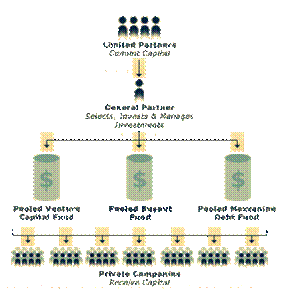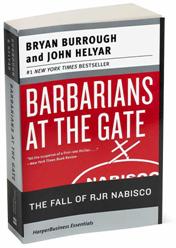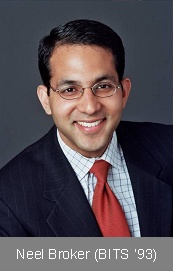| |
BITSians on Wall Street
By Anupendra Sharma (’87 Eco Instru), Sandeep Mukherjee (’95 Phy Mech)
Private Equity
Here’s a business problem. You want to buy a store in Delhi that makes Rs10K of profit per year. The owner says – You can have it for Rs200K or 20X the Price to Earnings ratio.
Now if you gave him Rs200K from your personal savings, the 5% annual return on your investment may not seem very attractive, especially when India’s stock markets are headed for the stratosphere.
 So here’s the private equity spin on it. You pay Rs200K for the store, using Rs80K from your personal savings, and borrowing the remaining Rs120K from the bank. To secure the loan, you place the store as collateral. So here’s the private equity spin on it. You pay Rs200K for the store, using Rs80K from your personal savings, and borrowing the remaining Rs120K from the bank. To secure the loan, you place the store as collateral.
Then you incentivize the store management by giving them some piece of the upside, or you bring in a new management team that has retail expertise to make the store more profitable and efficient. By the end of the first year, you are finished fixing it, and it is generating Rs20K per year in profit. In six years, you have paid off Rs120K the loan, and now almost own the store. You put it back on the market and sell it for 20X earnings or Rs400K. You pocket the entire sum – a handsome profit of Rs320K on your original investment, a return of 41% over five years.
This is a simplistic example, but this is essentially how it works. If you are able to leverage up the store even further by using only Rs40K of equity and $160 of debt, you would have generated a 73% return on your investment.
The wider definition of Private equity includes venture capital (early stage), growth capital, and Leveraged Buyouts (LBOs). LBOs typically focus on more established companies with stable cash flow characteristics that can support a high level of debt (or leverage) Private Equity firms typically take full control of a company, sit on the Board of Directors, and act as partners to the management team to help them grow the business.
Private Equity in its current form was spearheaded by Jerome Kohlberg, Jr., and cousins Henry Kravis and George R. Roberts, all of whom had previously worked together at Bear Stearns, a large Wall Street firm. The three partners created Kohlberg Kravis Roberts, or KKR, in 1976, which has become the worlds’ most storied private equity firm. This firm became famous in the book, Barbarians at the Gates, which details the takeover of RJR Nabisco. The $25 billion deal remains the largest of all time.
Private equity firms put in anywhere between 20-50% equity, and use leverage to make up the rest of the purchase price. They seek to create value in three ways: (i) paying down debt, (ii) improving the underlying cash flow characteristics through growth and operational improvement initiatives, and (iii) exiting the business at a higher cash flow multiple than the acquisition multiple.
As the industry has matured, private equity firms have identified specific focus areas – either by size of transaction (large: >$1 billion, mid-market: $100 million to $1 billion, lower middle market: $25 million - $100 million) by industry vertical (eg: healthcare, consumer, media and telecom, etc.), or most recently, but functional specialization (eg: turnarounds, sourcing expertise, etc.)
The past year has seen an unprecedented growth in capital directed towards private equity, creating a universe of “mega-funds”. Recent examples include The Blackstone Group’s $10 billion fund and Warburg Pincus’ $8 billion fund. As Private Equity firms raise larger and larger funds, they are being able to buy companies that would not find buyers amongst strategic (or competitor) firms. When you add the leveraged financing you can receive, these sums become significant.
The past few years have seen a huge interest in private equity in India, with many Greenfield and global private equity firms opening shop. Examples of Greenfield funds include ChrysCap and Westbridge, and examples of global private equity firms in India include Temasek, Warburg Pincus, The Blackstone Group and The Carlyle Group.
Private Equity firms have historically generated attractive returns for their investors. A recent example of a highly successful investment is Warburg Pincus’ $300 million investment in Bharti Televentures which generated $1.3 billion in returns in a short span of time. In mature markets such as the US and western Europe, IRRs of 15-20% are typically the benchmarks set by high performing funds.
 Professionals in Private Equity firms make their money based on performance over the life of a fund (typically 5-8 years) – making it a long term game (unlike investment banking or hedge funds, where annual compensation is based upon the previous year’s performance). The capital for funds are primarily raised from institutional investors such as pension funds and large financial institutions. Fund professionals earn 1-2% annually as a management fee to fund the ongoing operations. The upside comes from the “carry” – which represents 20% of the fund’s profits over its life. Thus, for a $300 million fund, with a 15% IRR over a 5 year period, the fund gains are $300 million, resulting in a $60 million payout to the partners of the fund. Professionals in Private Equity firms make their money based on performance over the life of a fund (typically 5-8 years) – making it a long term game (unlike investment banking or hedge funds, where annual compensation is based upon the previous year’s performance). The capital for funds are primarily raised from institutional investors such as pension funds and large financial institutions. Fund professionals earn 1-2% annually as a management fee to fund the ongoing operations. The upside comes from the “carry” – which represents 20% of the fund’s profits over its life. Thus, for a $300 million fund, with a 15% IRR over a 5 year period, the fund gains are $300 million, resulting in a $60 million payout to the partners of the fund.
The industry is highly relationship driven, with with strong connections to the banking community as well as senior corporate professionals. John Major, the former UK Prime Minister is Chairman of Carlyle Group Europe. Texas Pacific Group hired Vivek Paul (1975) to its venture arm for investing in lifesciences, but he is also focussed on doing Private Equity deals related to India. Vikram Pandit, head of Morgan Stanley’s Investment Bank, recently left to start a Private Equity firm aimed at investing in India. Jack Welch has worked with Clayton Dublier & Rice, another top Private Equity firm, since he left GE.
 Neel Broker currently works for a Private Equity firm in New York called ICV Capital Partners. 4 months after graduating from Pilani in 1997 he joined BT Alex.Brown (now Deutsche Bank) in New York. He spent close to 3 years with them in New York and London and then completed an MBA at Wharton. In 2002, he joined McKinsey & Company where he worked in both South East Asia and in New York. He joined ICV in May 2005. Neel Broker currently works for a Private Equity firm in New York called ICV Capital Partners. 4 months after graduating from Pilani in 1997 he joined BT Alex.Brown (now Deutsche Bank) in New York. He spent close to 3 years with them in New York and London and then completed an MBA at Wharton. In 2002, he joined McKinsey & Company where he worked in both South East Asia and in New York. He joined ICV in May 2005.
Looking back, the biggest stumbling block Neel faced initially getting a foothold onto Wall Street in 1997 was convincing firms of the credibility of his academic credentials from BITS Pilani. Unlike the IITs, BITS had not yet developed strong brand name recognition in the financial community, hence hirers were unsure of how much weight to place on the BITS name during the recruiting process. Eventually, what gave them comfort was the fact that Neel referenced BITS’s strong college rankings in India, and explained to them that BITS was co-founded by MIT, was structured on the MIT model, and today boasts a strong alumni community in India and overseas. Additionally, Neel had already done his GMAT exam, which provided a useful metric for evaluation..
At ICV, Neel spends a bulk of his time either evaluating new acquisition opportunities, or working with ICV’s existing portfolio companies on value creation initiatives. The combination of his I-Banking and consulting experience are particularly useful, since they contribute both, deal structuring and execution skills, as well as skills relating to working with management teams on diverse topics such as operations, marketing, and strategy, to ICV.
While there are few specific academic courses that he finds directly applicable on a day-to-day basis on his job, the analytical rigor, structured approach to problem solving, and the ability to multi-task and manage time efficiently are indispensable assets of his BITS education.
How to get into Private Equity?
Private equity is rarely a “first job off campus” for anyone. Private equity firms usually have small teams, and hence expect new hires to contribute from day 1, while having a long term career horizon with the Firm. Hiring decisions are highly driven by a combination of 3 factors:
(i) Academic and professional pedigree: At the pre-MBA level, experience at a good investment bank remains a good route to get into Private Equity. Consulting is also becoming a breeding ground for junior private equity professionals. As more junior professionals get private equity experience pre-MBA, a high percentage of post-MBA hiring takes place from the cohort of graduates with prior private equity experience. Larger private equity firms are beginning to establish in-house operations and consulting teams for their portfolio companies, and look to consulting firms and operating executives to fill these positions,
(ii) Relationships: Referrals are a common way to get one’s foot into the door. Unlike larger banks or consulting firms, private equity firms have a small margin for error in their hiring decisions, given their small size and infrequent hiring cycles. In private equity, as on Wall Street in general, the most powerful qualification is having a good professional reputation with mentors willing to stand behind you and “blow your trumpet” for you.
(iii) Timing: Hiring cycles for post-MBA hires at small to mid size firms are closely tied to the raising of a new fund. Hence, the process can often be frustrating since although one may have the right pedigree and right relationships, it may be a few years before a new position opens up at one’s “dream fund”.

McKinsey has been another firm from where a number of people have ended up in Private Equity. Neel Broker and Manish Sinha (see Hedge Fund article) both worked at McKinsey prior to joining the financial services industry. Manish Sinha says “You would find many Management Consultants, especially McKinsey alums in Private Equity. Private Equity in addition to financial analysis and valuation calls for understanding industry trends, segmentation, strategic positioning and operational efficiency improvements as the PE firm takes on a more active role in the companies they buy. In my view Mck experience comes in handy.” |
|

